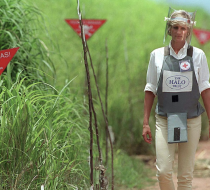Princess Diana’s 1997 landmine walk: ‘I come with my heart’ Favorite
It's an evocative image — and it was intended to be: Diana, Princess of Wales, wearing a protective visor and flak jacket, walking through a live minefield in Huambo, Angola. The image of the princess, at the time one of most famous women in the world, surrounded by danger, made headlines across the world.
Princess Diana visited Angola as a guest of the International Red Cross in January of 1997. The nation at the time was experiencing a brief and fragile period of peace from a civil war that had raged for the previous 20 years. The war would ultimately reignite in 1998, and continue for another four years.
The conflict had left the country contaminated by more than 15 million landmines. These hidden weapons, often scattered near towns and villages, were having a devastating effect, causing extensive civilian casualties, and hindering any effort at post-conflict recovery. At the time of the princess's visit, one in every 330 people in Angola had lost a limb.
Stepping out into a minefield, she walked a cleared path alongside mine removal expert Paul Heslop from the Halo Trust, an organisation dedicated to clearing landmines. He later confessed to the BBC, "My mind was in overdrive trying to make sure I wasn’t going to be the most famous person in the world the next day for blowing up the Princess of Wales".
The walk through the minefield was not merely a symbolic act but a challenge to governments to stop ignoring the terrible suffering caused by these weapons and a call for international action to eradicate their use. Her advocacy of this cause would prove instrumental in mobilising public opinion in support of a ban on landmines, and rallying diplomatic pressure for demining efforts.
But her public endorsement of the Red Cross's campaign for a worldwide ban on mines was out of step with the UK government policy at the time, and enraged some Conservative politicians. Junior Defence Minister, Earl Howe, described her as a "loose cannon" and "ill-informed" on the issue.
Reporters on the ground in Angola quizzed her on the political storm that was brewing back home in the UK. A clearly exasperated Diana replied: "I'm only trying to highlight a problem that is happening around the world, that's all."
She seemed visibly upset by the media's questions and the political row she had unexpectedly found herself caught up in. "I'm not a political figure, nor do I want to be one. I come with my heart and I want to bring awareness to people in distress, whether it is in Angola or any part of the world. The fact is I am a humanitarian figure, always have been and always will be," she said.
Undeterred, she went to deliver a speech at the Royal Geographical Institute in London the following June, calling for an end to "the plague on Earth caused by landmines". She then travelled to Bosnia in August to see landmine clearance activities, and to meet victims who had sustained their injuries during the country's brutal civil war in the 1990s.
A problem on an immense scale
The media spotlight, and the public's fascination with Diana sparked a boost in funding for demining projects and galvanised governments to address the crisis, resulting in the creation of the Ottawa Treaty in 1999, which aimed to eliminate the use, production, stockpiling and transfer of anti-personnel landmines.
The princess would not live to witness the fruits of her labour. Just a couple of weeks after her visit to Bosnia, she was killed in a car crash in Paris on 31 August 1997.
Tony Blair, the newly elected UK Prime Minister, pledged to ratify the Ottawa Treaty in time for the anniversary of her death.
But the landmine issue is far from solved, and the scale of the problem is immense. A number of key countries refused to sign the 1999 treaty banning their use, including the US, Russia, China, Israel and Iran, while India, Myanmar, Pakistan and South Korea still manufacture them.
Even in areas where the conflict has long ended, the landmines create a devastating and deadly legacy. From Afghanistan to Croatia, Cambodia to Libya, these weapons lie buried, waiting to be stepped on, continuing to indiscriminately kill and maim people for years afterwards.
Indeed, no one really knows how many landmines there are globally; some date back to World War Two, their locations long since forgotten. According to the International Campaign to Ban Landmines, at least 5,544 people were killed or injured by mines around the world in 2021. Most of those victims were civilians. Half of them were children.
The Mines Advisory Group (MAG) says that in Angola, where the princess made her iconic walk, an area of 7,300 hectares (the equivalent to more than 10,000 football pitches) still needs to be cleared of mines.
And new mines are being laid in conflict areas all the time. Ukraine's government has said that 724 people have been blown up by mines, with 226 of them being killed, since Russia launched its full-scale invasion on 24 February 2022. There is thought to be a 174,000 sq km area of Ukraine now contaminated by landmines.
However, the campaign Diana championed endures. Her sons, Prince William and Prince Harry, have now taken up the mantle of her advocacy, and organisations such as the Halo Trust, MAG and the International Campaign to Ban Landmines remain committed to global demining efforts, and supporting communities blighted by these hidden, deadly weapons.






